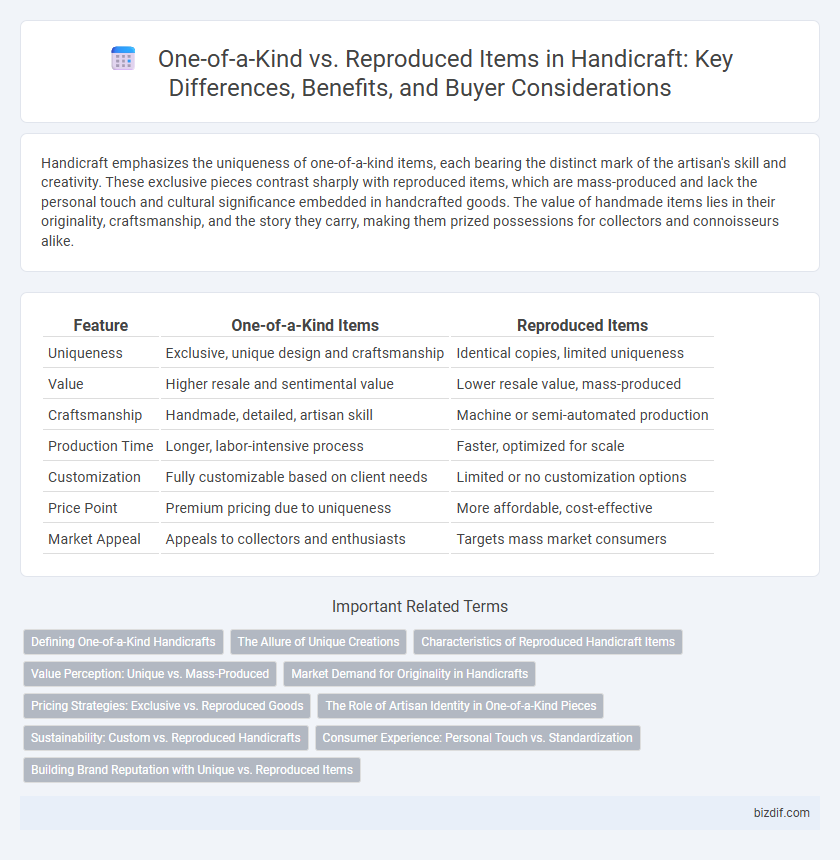Handicraft emphasizes the uniqueness of one-of-a-kind items, each bearing the distinct mark of the artisan's skill and creativity. These exclusive pieces contrast sharply with reproduced items, which are mass-produced and lack the personal touch and cultural significance embedded in handcrafted goods. The value of handmade items lies in their originality, craftsmanship, and the story they carry, making them prized possessions for collectors and connoisseurs alike.
Table of Comparison
| Feature | One-of-a-Kind Items | Reproduced Items |
|---|---|---|
| Uniqueness | Exclusive, unique design and craftsmanship | Identical copies, limited uniqueness |
| Value | Higher resale and sentimental value | Lower resale value, mass-produced |
| Craftsmanship | Handmade, detailed, artisan skill | Machine or semi-automated production |
| Production Time | Longer, labor-intensive process | Faster, optimized for scale |
| Customization | Fully customizable based on client needs | Limited or no customization options |
| Price Point | Premium pricing due to uniqueness | More affordable, cost-effective |
| Market Appeal | Appeals to collectors and enthusiasts | Targets mass market consumers |
Defining One-of-a-Kind Handicrafts
One-of-a-kind handicrafts are unique creations crafted by artisans, showcasing individual creativity and skill that cannot be exactly duplicated. These items often incorporate rare materials, traditional techniques, and personalized design elements, making each piece distinct and valuable. Unlike reproduced items, one-of-a-kind handicrafts emphasize originality and cultural authenticity, reflecting the artisan's personal expression and heritage.
The Allure of Unique Creations
One-of-a-kind handicraft items captivate collectors and enthusiasts with their exclusivity and intricate details, often reflecting the artisan's personal touch and cultural heritage. These unique creations command higher value due to their rarity and the time-intensive techniques involved, distinguishing them from mass-produced, reproduced items that prioritize uniformity and lower cost. The allure of unique handicrafts lies in their ability to convey authenticity and storytelling, making each piece a treasured work of art rather than a mere commodity.
Characteristics of Reproduced Handicraft Items
Reproduced handicraft items feature consistent design patterns, allowing for mass production and affordability while maintaining a traditional aesthetic. These items often utilize standardized materials and techniques, ensuring uniform quality and availability across markets. Unlike one-of-a-kind pieces, reproduced handicrafts lack individual artist signatures but offer reliable durability and widespread accessibility.
Value Perception: Unique vs. Mass-Produced
One-of-a-kind handicraft items hold higher value perception due to their uniqueness and the artisan's personal touch, making each piece irreplaceable and exclusive. Reproduced items, while more accessible and consistent in quality, often lack the emotional connection and individuality that collectors and buyers seek. This distinctiveness drives demand for handcrafted originals, elevating their worth above mass-produced alternatives in the market.
Market Demand for Originality in Handicrafts
The market demand for originality in handicrafts strongly favors one-of-a-kind items due to their unique craftsmanship, cultural authenticity, and personalized appeal, which cannot be replicated by mass-produced goods. Consumers seeking exclusive decor and meaningful gifts prioritize handmade creations that showcase artisans' skills and traditional techniques, enhancing the perceived value and emotional connection. Reproduced items, while more affordable and uniform, often lack the distinctiveness and story that drive higher demand in niche artisanal markets.
Pricing Strategies: Exclusive vs. Reproduced Goods
One-of-a-kind handicraft items command premium pricing due to their uniqueness, craftsmanship, and limited availability, creating a perception of exclusivity and value among buyers. Reproduced items are priced more competitively, leveraging economies of scale and consistent production methods, appealing to a broader market by offering affordable access to artisanal designs. Pricing strategies must balance exclusivity with market demand, ensuring that unique pieces retain their value while reproduced goods maximize volume sales without diluting brand prestige.
The Role of Artisan Identity in One-of-a-Kind Pieces
Artisan identity plays a crucial role in one-of-a-kind handicraft pieces by embedding cultural heritage, personal creativity, and traditional techniques unique to each craftsman. These singular items carry intrinsic value that mass-produced or reproduced pieces lack, as they authentically represent the artisan's skill and story. Consumers often seek one-of-a-kind handicrafts for their exclusivity and the meaningful connection to the artisan's identity and craftsmanship.
Sustainability: Custom vs. Reproduced Handicrafts
One-of-a-kind handicrafts emphasize sustainability by utilizing local, natural materials and minimal production resources, reducing environmental impact compared to mass-produced reproduced items. Custom craftsmanship promotes slower consumption cycles and supports artisan livelihoods, fostering eco-friendly practices and cultural preservation. Reproduced handicrafts often rely on standardized processes and synthetic materials, contributing to greater waste and carbon footprints.
Consumer Experience: Personal Touch vs. Standardization
One-of-a-kind handicraft items offer consumers a unique personal touch that evokes emotional connection and exclusivity, making each piece feel special and irreplaceable. Reproduced items emphasize standardization, ensuring consistent quality and accessibility but often lack the individuality that consumers seek in artisanal products. The consumer experience significantly differs as bespoke craftsmanship delivers authenticity and uniqueness, while mass-produced handicrafts prioritize uniformity and efficiency.
Building Brand Reputation with Unique vs. Reproduced Items
One-of-a-kind handicraft items enhance brand reputation by showcasing originality and artisanal skill, attracting customers who value exclusivity and craftsmanship. Reproduced items offer consistency and scalability but may dilute brand identity by lacking the distinct personality each unique piece carries. Emphasizing limited edition or custom-made products strengthens consumer loyalty and positions the brand as a leader in authentic, high-quality handicraft.
One-of-a-kind items vs Reproduced items Infographic

 bizdif.com
bizdif.com